
Do you want to save your WordPress blog posts to your computer?
Normally, you can make a WordPress backup and save it on your computer. However, these backups are not readable or easy to share without installing WordPress again.
In this article, we’ll show you how to easily save a copy of your blog content that you can read, share, or even convert to an eBook.

Why Save Your Blog Posts to Your Computer
There are several reasons to save your blog posts to your computer.
The most common reason is to create a back up of your blog, so that you can restore it later. You may want to move it to a new WordPress website or just keep it safe as a security precaution.
Or you may want to close and delete your WordPress website, but want to preserve your blog content in a readable format. Instead of saving them as back up files, you can save all of your blog posts as PDF or an eBook, so you can easily read or share your articles.
Another common reason is to move from another blogging platform to WordPress. To do this you’ll need to save your blog posts and then import them into WordPress.
There are multiple ways to save and download your blog posts. Depending on your needs, you can choose the method that best suits you.
- Creating a backup of your entire blog
- Creating a PDF or ebook of your blog posts
- Printing a book of your blog posts
- Saving your blog to migrate
- Saving your WordPress.com blog posts
Creating a Backup of Your Blog
This method is recommended if you just want to make a backup of your blog posts for safekeeping.
It allows you to restore your blog posts on any other WordPress website. However, it does not save your blog posts in a readable or shareable format.
WordPress has a built-in feature to export your blog posts. Simply go to Tools » Export. page inside your WordPress admin area. Here, you can choose to download your entire site, or only your blog posts.
After that, you can click on the Download Export File button and WordPress will download all your blog posts in XML format. This file can be used to restore your site, or to migrate to another domain or a different web host.
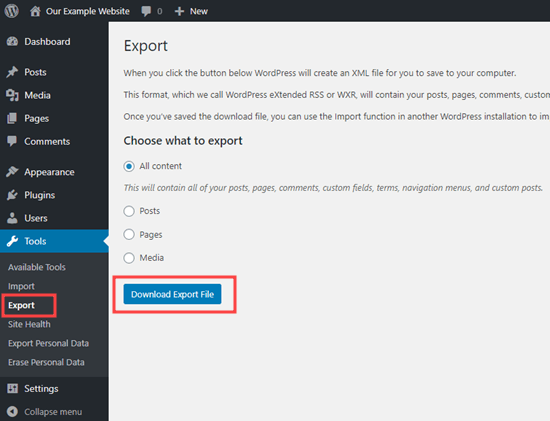
You can also download your entire media library and save your images and videos separately.
However, if you want to keep a backup of your entire WordPress site, then the export tool is not the ideal method. It will not save any other website data, settings, your WordPress theme, or plugins.
For that, you will need to use a proper WordPress backup plugin. These plugins allow you to make a complete WordPress website backup which you can then save on your computer or upload to cloud storage like Google Drive or Dropbox.
You can also set them up, so they automatically take backups at regular intervals and save them remotely.
We recommend using UpdraftPlus, which is easy to use and supports multiple cloud storage options. For more details, see our guide on setting up WordPress backups using UpdraftPlus.
Creating a PDF or eBook of Your Blog
The problem with WordPress backup plugins or the default export method is that your blog posts will not be readable outside WordPress.
This is why many users prefer to save blog posts as PDF because it makes it easy to read, share, or republish the blog post as an eBook.
Let’s take a look at how to easily save your blog posts as PDF to your computer.
If you’re only looking to save a single blog post, then the easiest way is to open it in a browser and use the keyboard shortcut CTRL + P (for Windows) or CMD + P (for Mac). This will open the browser’s print settings window.
You can now change the Destination to ‘Save as PDF’ and click on the ‘Save’ button to download it to your computer.
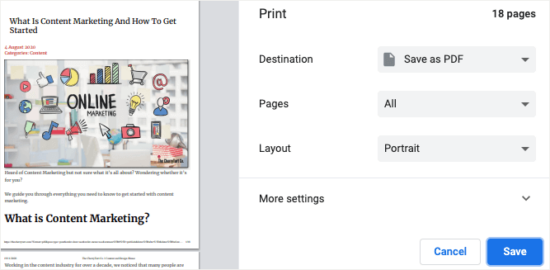
Now, if you want to save all your blog posts as PDF at once, then the easiest way to do that is by using a WordPress plugin.
First, you need to install and activate the Print My Blog plugin. For more details, see our step by step guide on how to install a WordPress plugin.
Upon activation, you need to visit Print My Blog » Print Now page to configure settings. From here, you can choose to print a physical copy, save a PDF file, create an eBook, or save it in HTML format.
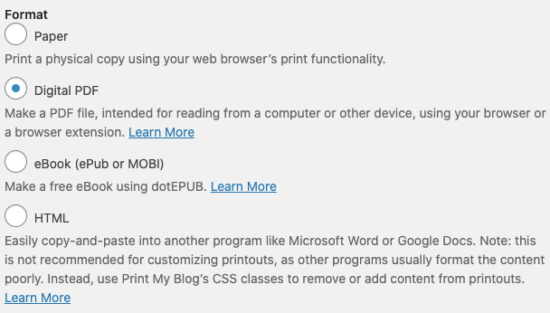
You can select Digital PDF to create and save a readable PDF file on your computer. Alternatively, you can choose eBook if you want to create a digital book that you can publish online.
After that, click to expand the ‘Show More Print Options’ menu to customize your blog copy.
In most cases, the default settings are good enough. But you may want to go through them just to make sure the blog copy is exactly what you need.
From the drop-down menu, you can apply a number of filters. For instance, you can choose to save only posts or only pages of your WordPress site.
You can also select what order you want the posts to appear, whether you want the oldest or the newest posts first.

Another option is to filter the posts by their status. You can choose to download only the published posts, or include drafts and deleted posts that are in your Trash folder.

You can also filter your posts by categories, tags, authors, and dates. This is handy if you want to download only particular categories for a project, or if you want a document of every article written by a single author.
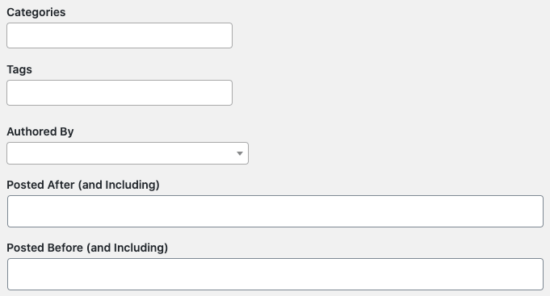
The plugin also allows you to choose what header and post content you wish to appear in your saved copy. By default, the date and the plugin’s branding is selected, but you can unselect this if you don’t want this information to appear in your PDF.
You can apply these filters to every post and choose what information you want to appear for each post such as the published date, comments, URL, and author.
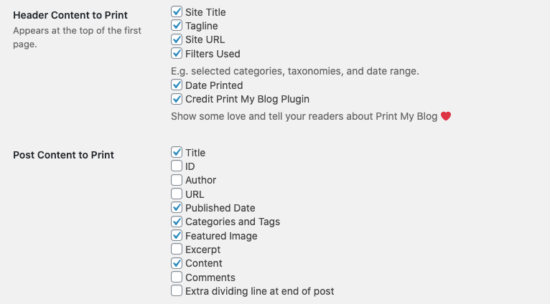
Lastly, you can determine your page layout. Print My Blog basically creates a single PDF file for all your blog content. You can choose to have each new post start on a new page to ensure there is proper separation.
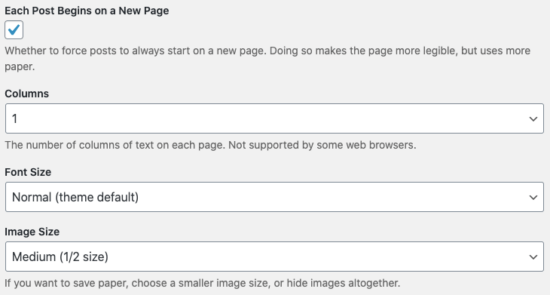
You can also customize the font size, image size, and choose whether you want to include hyperlinks.

Once you are satisfied with the settings, click on the ‘Prepare Print-Page’ button to continue. To print an eBook, you need to use the dotepub extension.
To save a PDF file, click on the ‘Print to PDF’ button to save the file.

This will bring up your browser’s print settings. Select Save as PDF option and then click on the save button to save the PDF file to your computer.

Note: The save to PDF functionality works best with Google Chrome and Microsoft Edge browsers.
If you’ve created an eBook, you might find our guide on how to add an eBook download to your WordPress site helpful.
Printing your Blog Posts as a Book
You can also convert your blog into a physical book for distributing it among friends or at an event. You could also make an online store to sell it from your website.
Blog2Print converts your blog on WordPress, Tumblr, Typepad and Blogger into professionally bound books.
They also let you turn your Instagram feed into a book!
Blog2Print automatically formats your content. You can select what content you want to include, customize your book cover, add photos and supplemental text to make the book seem more like a published book rather than a series of blog posts.

Another platform you can use is Into Real Pages. They have four formats you can choose from, along with 8 wonderful themes. You get to design your own cover and add additional text and photos. They also offer good deals on bulk printing.
Saving Your Blog Posts to Migrate Platforms
A lot of folks want to save their blog posts, so they can move to them elsewhere. Now there are two common types of blog migrations.
- Moving a WordPress blog to another WordPress blog. This happens when a user is changing their WordPress hosting company or domain name, and they need to move their WordPress files to the new location.
- Moving from a third-party platform to WordPress. A lot of folks start with other blogging platforms and later on want to move their blogs to WordPress.
We will talk about both user cases and will show you how to properly save your blog posts and move them over.
1. Migrating a WordPress Blog
To move to a new domain, a different host, or another top blogging platform, you need to create a copy of your blog. This copy can then be used to migrate over.
You can use a migration plugin that automatically makes a backup for you and lets you move to a new domain or new host.
There are plenty of migration plugins to choose from, out of which Duplicator Pro is one of the best on the market.
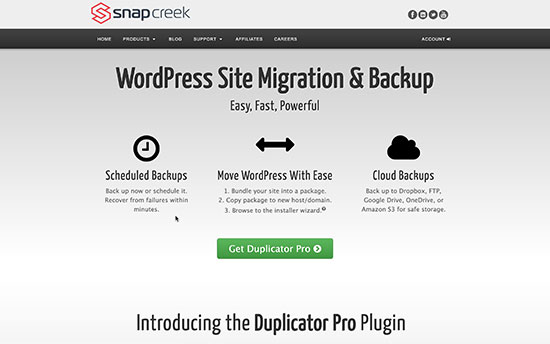
If you want to move your site from one domain to another, but you’re worried about losing your blog content, see our guide on how to move WordPress to a new domain. This guide also ensures you don’t lose any of your SEO efforts.
If you’ve been blogging on a subdomain and want to merge it with your main domain, the process is fairly simple. But you need to follow it step by step to make sure you don’t face errors. See our guide on moving subdomain to root domain in WordPress.
You can also move between hosts and servers but there’s a risk of downtime. Our guide on how to move WordPress to a new host or server shows you how to switch over without losing any content or having downtime.
2. Migrating a Third-Party Blog to WordPress
A lot of users want to save their blog posts, so they can move all their content to WordPress.
There are two types of WordPress blogs. WordPress.com which is a hosting service and WordPress.org which is also called self-hosted WordPress. For more details, see our guide on the difference between WordPress.com vs Wordress.org with detailed pros and cons.
You’ll need WordPress.org because it gives you instant access to all WordPress features out of the box.
To get started, you’ll need a domain name and a WordPress hosting account. The domain name is your website’s address (e.g. wpbeginner.com), and the hosting account is where all your website files are stored.
We recommend using Bluehost. They are one of the top hosting companies in the world and an officially recommended WordPress hosting provider.
They are offering WPBeginner users, a generous discount on hosting with a free domain name and SSL certificate.
→ Click Here to Claim This Exclusive Bluehost Offer ←
Once you have signed up for a hosting account, you can follow our step by step tutorial on how to start a WordPress blog for the complete setup.
After the set up, you’ll reach your WordPress admin dashboard.
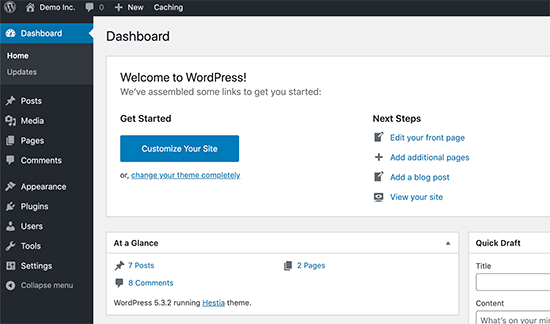
WordPress powers over 38% of all websites on the internet. This is why many users want to switch blogging platforms and use WordPress.
You can easily import your blog posts from other blogging platforms to your WordPress blog. Depending on which platform you are moving from, you can follow the step by step instructions from our guides below.
- Moving your blog from WordPress.com to WordPress.org
- Moving your blog from Blogger to WordPress
- Moving a website from Weebly to WordPress
- Moving a website from Wix to WordPress
- Moving a website from Joomla to WordPress
- Moving a website from Squarespace to WordPress
- Move articles from Medium to WordPress
- Moving your blog posts from Tumblr to WordPress
- Moving your blog from LiveJournal to WordPress
- Moving from GoDaddy Website Builder to WordPress
Saving Your WordPress.com Blog Posts
If you are using WordPress.com, then you can still save your WordPress.com blog posts to your computer. You can also move to WordPress.org or use the downloaded file as a backup that you can restore at any time.
First, you need to login to your blog and then go to the Tools » Export » Export all. WordPress.com will then create an XML file and your browser will download it to your computer.

This file uses the same format as WordPress.org, which means you can easily use it to move your blog from WordPress.com to a WordPress.org blog.
We hope this article helped you learn how to save blog posts to your computer. You may also want to see our guide on how to increase your blog traffic by 406%, and over 30 proven ways make money blogging using WordPress.
If you liked this article, then please subscribe to our YouTube Channel for WordPress video tutorials. You can also find us on Twitter and Facebook.
The post How to Easily Save a Blog Post to Your Computer (5 Methods) appeared first on WPBeginner.
Post a Comment